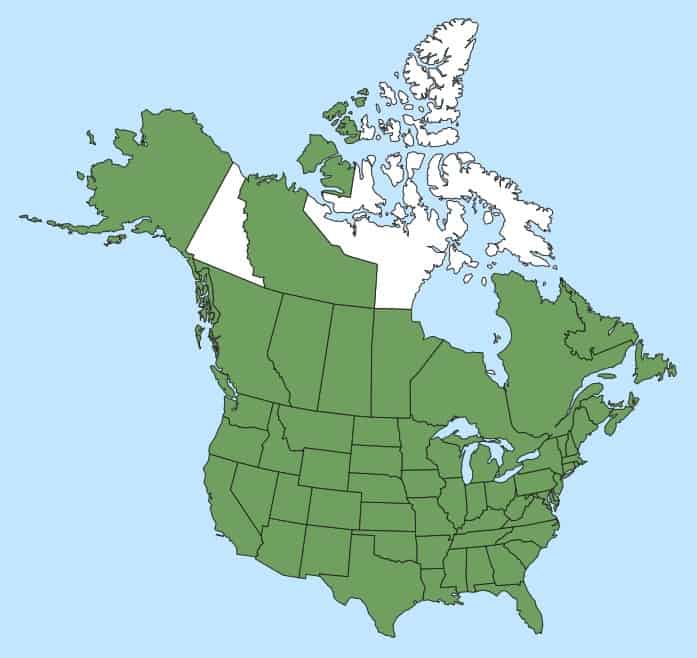Ambrosia artemisiifolia
Overview
Aperçu
Regulation :
Remarques Réglementation:
- CFIA Weed Seeds Order - Class 3: Secondary Noxious Weed Seeds
Regulation Notes:
Distribution :
Répartition :
Native to North and South America, and widely introduced elsewhere including Europe, Africa, temperate and tropical Asia, Australasia and the Pacific Islands (USDA-ARS 2020). Widely distributed in North America with both native and introduced populations present in the U.S. and Canada (Brouillet et al. 2010+; USDA-NRCS 2020). Occurs across Canada except in Nunavut and Yukon (Bassett and Crompton 1975; Brouillet et al. 2010+).
Habitat and Crop Association :
Habitat et Cultures Associées :
This species grows in disturbed areas such as: cultivated fields, fencerows, pastures, shores, canals, quarries, railway lines, roadsides and wasteland (Bassett and Crompton 1975; Darbyshire 2003; CABI 2020). Found in a range of both agronomic and horticultural crops, particularly in cereals and crops cultivated in rows such as Zea mays (corn), Solanum lycopersicum (tomato) and Arachis hypogaea (peanut) (Basset and Crompton 1975; CABI 2020).
Economic Use, cultivation area, and Weed Association :
Utilisation économique, zone de culture et association de mauvaises herbes :
Duration of Life Cycle :
Durée du cycle vital:
Annual
Dispersal Unit Type :
Type d’unité de dispersion :
Bur
General Information
RENSEIGNEMENTS GÉNÉRAUX
A single plant typically produces more than 3,000 seeds, although up to 62,000 seeds on large plants have been reported (Bassett and Crompton 1975). Seeds can remain viable when buried for up to 39 years (Bassett and Crompton 1975). This species is responsible for most of the allergic reactions to pollen in eastern North America (Bassett and Crompton 1975).
Ambrosia artemisiifolia burs are heavy and have no obvious dispersal mechanisms, and rely on human-mediated dispersal to move beyond their native range (Montagnani et al. 2017). A. artemisiifolia burs have been dispersed around the world as a contaminant in seed and grain crops (Bassett and Crompton 1975). Burs along road corridors have significant secondary dispersal caused by vehicle movements (Lemke et al. 2019).
.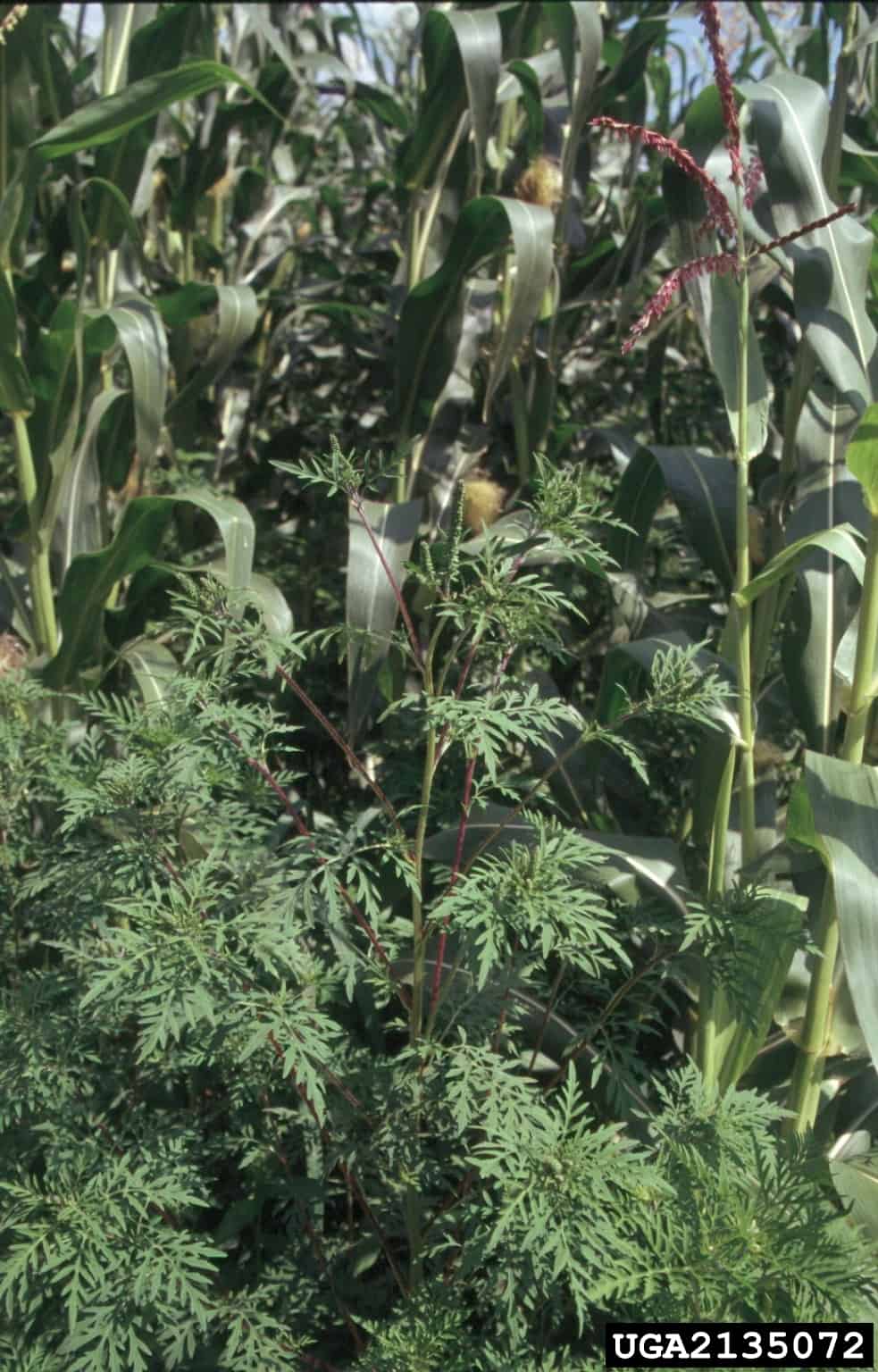
Ambrosia artemisiifolia plant (Barbara Tokarska-Guzik, University of Silesia, Bugwood.org)
Identification
Identification
-
Bur
Size
- Bur length*: 1.9 – 3.7 mm; width: 1.5 – 2.8 mm
*Note: minimum and maximum of 20 burs in a normal range of this species using image measurement (ISMA 2020)
Shape
- Bur is egg-shaped
Surface Texture
- Bur is generally smooth with shallow wrinkles
Colour
- Burs are generally dull dark grey with purple streaks, but can be straw-yellow, brown or grey coloured
Other Features
- Bur has a ring of several short spines at one end up to 1.0 mm long surrounding a longer central spine up to 2.0 mm long (Bassett and Crompton 1975)
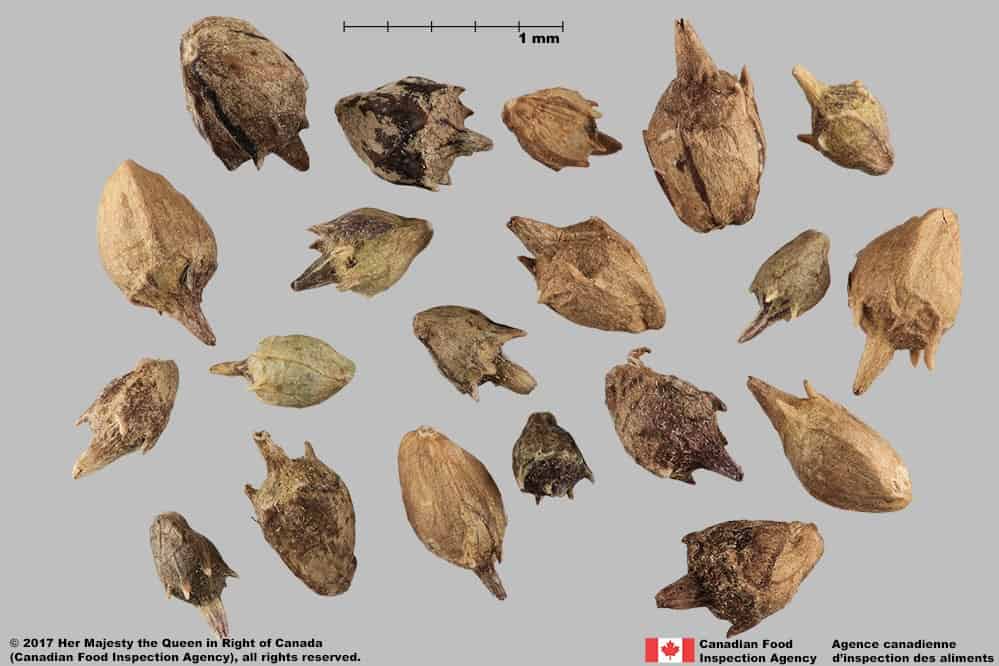
Common ragweed (Ambrosia artemisiifolia) burs


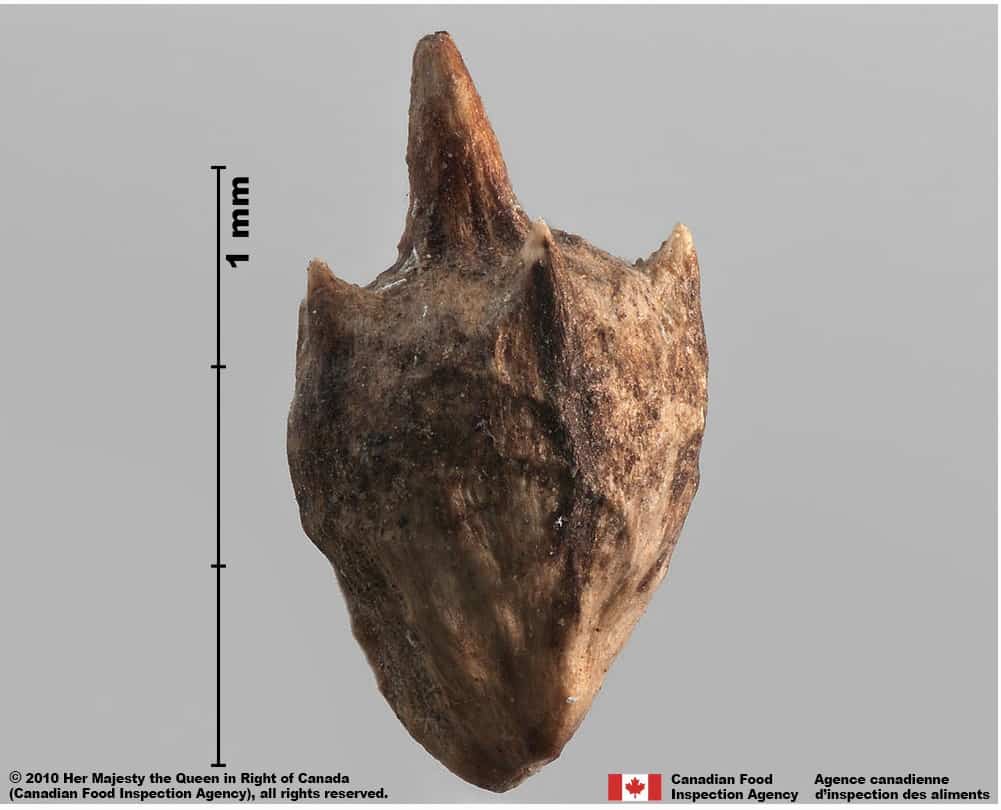
-
Achene
Size
- Achene length*: 1.5 – 3 mm; width: 1.5 mm
*Note: minimum and maximum of 5 achenes in a normal range of this species using specimen measurement (ISMA 2020)
Shape
- Achene is egg-shaped
Surface Texture
- Achene surface is smooth
Colour
- Achene is shiny dark brown coloured
-
Seed
Size
- Seed size same as achene size
Shape
- Seed is egg-shaped
Surface Texture
- Seed has a wrinkled texture
Colour
- Seed is whitish coloured, seed coat is brown (Bassett and Crompton 1975)
Other Features
- The seed coat is thin

Common ragweed (Ambrosia artemisiifolia) burs and one seed

-
Embryo
Size
- Embryo fills the seed
Shape
- Embryo is spatulate shaped, axial position
Endosperm
- Endosperm absent, nutritive tissue stored in the cotyledons
Other Features
- Cotyledons are a soft and oily texture
Identification Tips
CONSEILS POUR L’IDENTIFICATION
Ambrosia artemisiifolia burs are smaller than species such as A. trifida. In species with burs of a similar size, such as A. psilostachya, the distinguishing features are A. artemisiifolia’s well-developed, long spine surrounded by sharp-pointed smaller spines at the wide end of the bur. The burs of A. artemisiifolia may have missing or broken spines, but the central one appears thick and well-developed, even if only the base remains. The achenes of similar-sized species are difficult to distinguish if removed from the burs.
Additional Botany Information
AUTRES RENSEIGNEMENTS BOTANIQUES
Flowers/Inflorescence
- 10-100 staminate flowers are clustered into disc-shaped heads on flowering stalks, 1-3 pistillate flowers are clustered at the base of the staminate stalks (Bassett and Crompton 1975)

Ambrosia artemisiifolia flowers (Steve Dewey, Utah State University, Bugwood.org)

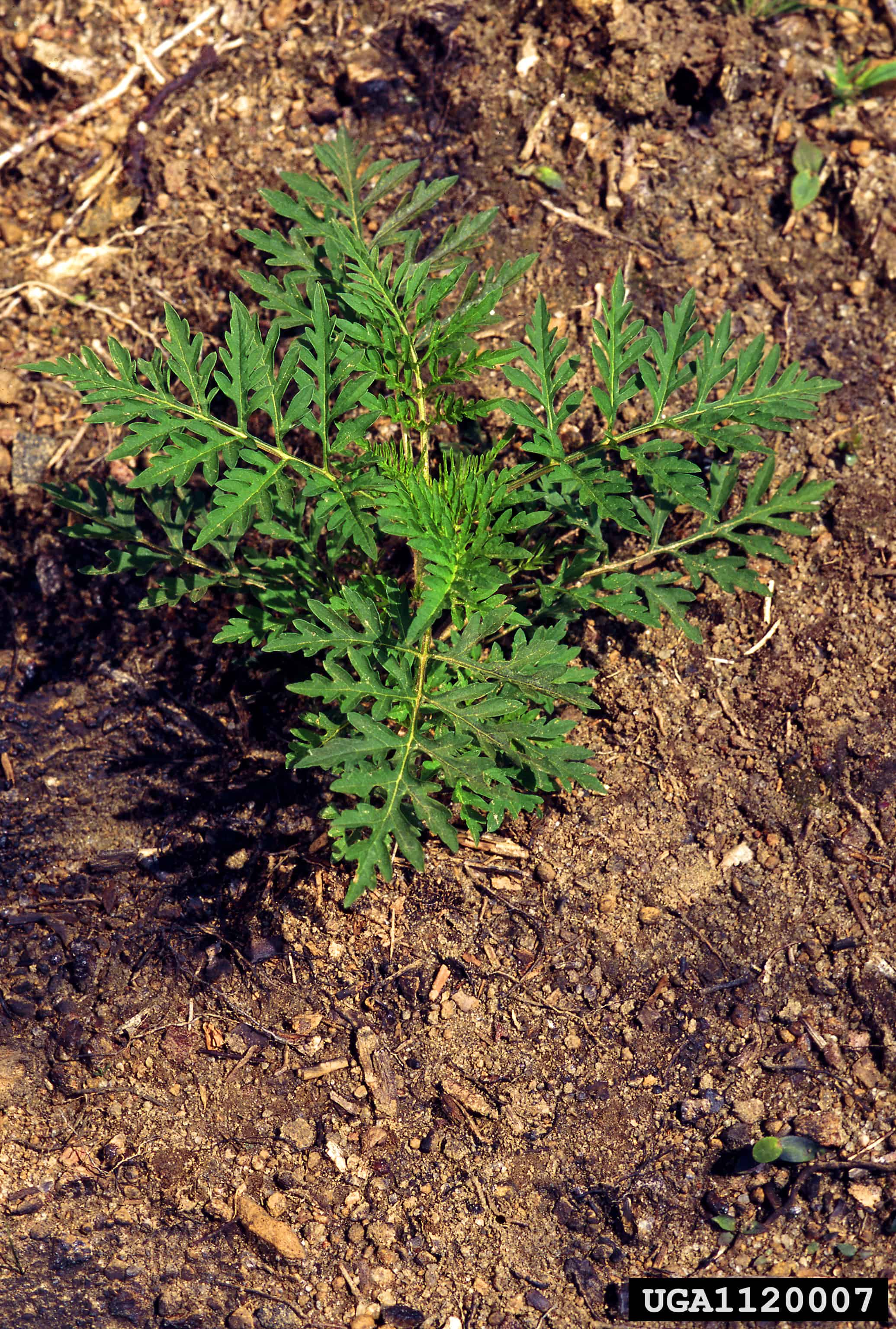


Similar Species
ESPÈCES SEMBLABLES
Similar species are based on a study of seed morphology of various species, and those with similar dispersal units are identified. The study is limited by physical specimen and literature availability at the time of examination, and possibly impacted by the subjectivity of the authors based on their knowledge and experience. Providing similar species information for seed identification is to make users aware of similarities that could possibly result in misidentification.
Ambrosia psilostachya DC. (perennial ragweed)
A. psilostachya burs are generally larger (length*: 2.4-4.6; width: 1.8-3.2 mm) with spines that are less developed. Burs have a central spine and may or may not have a ring of smaller spines. Generally lack the purple streaked colour pattern of A. artemisiifolia burs. It is difficult to distinguish between A. artemisiifolia and A. psilostachya achenes when the outer bur layer is removed.
*Note: minimum and maximum of 20 burs in a normal range of this species using image measurement (ISMA 2020)
Click to select species
Cliquez pour sélectionner les espèces

Ambrosia psilostachya
Comparison Window
Fenêtre de comparaison
MAIN SPECIES
ESPÈCES PRINCIPALES
Ambrosia artemisiifolia

Ambrosia artemisiifolia
Asteraceae
Common ragweed (Ambrosia artemisiifolia) burs
MAIN SPECIES
ESPÈCES PRINCIPALES
Ambrosia artemisiifolia

Ambrosia artemisiifolia
Asteraceae
Common ragweed (Ambrosia artemisiifolia) burs and one seed
MAIN SPECIES
ESPÈCES PRINCIPALES
Ambrosia artemisiifolia

Ambrosia artemisiifolia
Asteraceae
Common ragweed (Ambrosia artemisiifolia) bur
SIMILAR SPECIES
ESPÈCES SEMBLABLES
Ambrosia psilostachya

Ambrosia psilostachya
Asteraceae
Perennial ragweed (Ambrosia psilostachya) burs
SIMILAR SPECIES
ESPÈCES SEMBLABLES
Ambrosia psilostachya

Ambrosia psilostachya
Asteraceae
Perennial ragweed (Ambrosia psilostachya) burs
SIMILAR SPECIES
ESPÈCES SEMBLABLES
Ambrosia psilostachya

Ambrosia psilostachya
Asteraceae
Perennial ragweed (Ambrosia psilostachya) bur
SIMILAR SPECIES
ESPÈCES SEMBLABLES
Ambrosia psilostachya

Ambrosia psilostachya
Asteraceae
Perennial ragweed (Ambrosia psilostachya) bur wall partially removed showing achene
Need ID Help?
Besoin d’aide pour l’identification?
Reference(s)
Référence(s)
Bassett, I. J. and C. W. Crompton. 1975. The biology of Canadian weeds. 11. Ambrosia artemisiifolia L. and A. psilostachya DC. Canadian Journal of Plant Science 55: 463-476.
Brouillet, L., Coursol, F., Meades, S. J., Favreau, M., Anions, M., Bélisle, P. and Desmet, P. 2010+. VASCAN, the database of vascular plants of Canada. http://data.canadensys.net/vascan/ Accessed October 15, 2020.
Centre for Agriculture and Bioscience International (CABI). 2020. Invasive Species Compendium, CAB International, Wallingford, UK. https://www.cabidigitallibrary.org/journal/cabicompendium Accessed October 8, 2020.
Darbyshire, S. J. 2003. Inventory of Canadian Agricultural Weeds. Agriculture and Agri-Food Canada, Research Branch. Ottawa, ON.
Flora of North America (FNA) Editorial Committee, eds. 1993+. Flora of North America North of Mexico [Online]. 22+ vols. New York and Oxford. Accessed December 29, 2022.
Global Biodiversity Information Facility (GBIF) Secretariat. 2022. https://doi.org/10.15468/39omei Accessed via https://www.gbif.org/species/8002952 Accessed December 29, 2022.
Government of Canada (GC). 2016. Canadian Weed Seeds Order. https://laws-lois.justice.gc.ca/eng/regulations/SOR-2016-93/page-2.html (English) https://laws-lois.justice.gc.ca/fra/reglements/DORS-2016-93/page-2.html (French)
International Seed Morphology Association (ISMA). 2020. Method for Seed Size Measurement. Version 1.0. ISMA Publication Guide. https://www.idseed.org/authors/details/method_for_seed_size_measurement.html
Lemke, A., I. Kowarik and M. von der Lippe. 2019. How traffic facilitates population expansion of invasive species along roads: The case of common ragweed in Germany. Journal of Applied Ecology. 56: 413-422.
Montagnani C., R. Gentili, M. Smith, M. F. Guarino and S. Citterio. 2017. The worldwide spread, success, and impact of ragweed (Ambrosia spp.). Critical Reviews in Plant Sciences 36: 139-178.
U.S. Department of Agriculture-Agricultural Research Services (USDA-ARS). 2020. Germplasm Resources Information Network (GRIN), https://npgsweb.ars-grin.gov/gringlobal/taxon/taxonomysimple.aspx Accessed October 13, 2020.
U.S. Department of Agriculture-Natural Resources Conservation Service (USDA-NRCS). 2020. The PLANTS Database. National Plant Data Team, Greensboro, NC USA. http://plants.usda.gov Accessed October 13, 2020.



